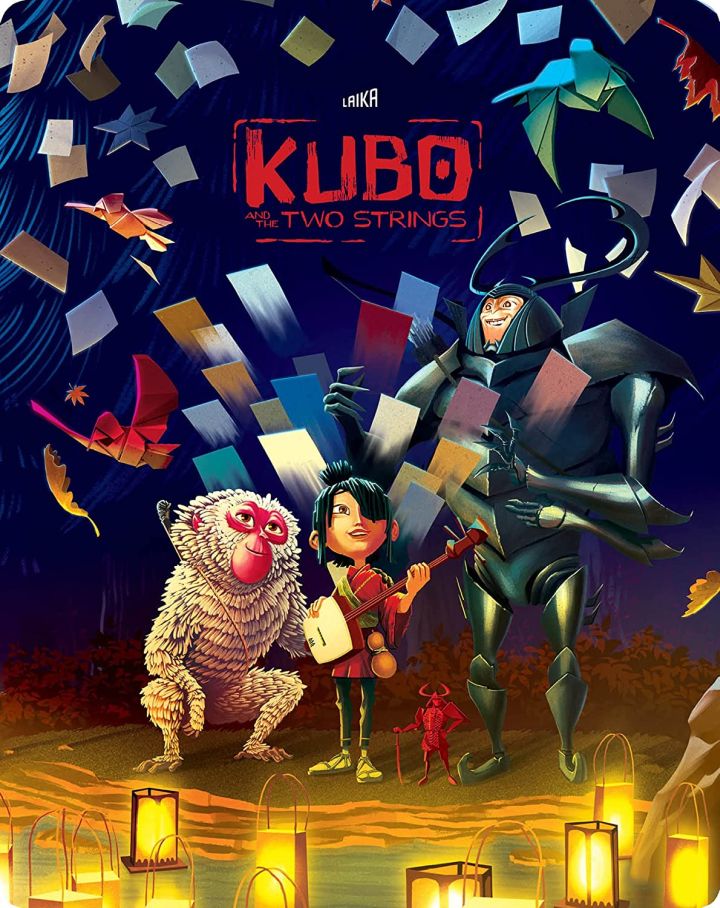
Kubo and the Two Strings is the story of an estranged family coming together. It is the story of a legend coming true, and in the coming true it becomes even more legendary. It is also a stop-motion animation film of astonishing achievement. It’s pretty good. I wish it had been perfect.
Kubo is a one-eyed young man in medieval kind-of Japan who tells stories in the town during festivals. His stories are accompanied by moving origami dolls. They’re animated by the magic of his shamisen playing. He always tells the story of Hanzo, the great warrior who fought the Moon King. And how it ends… nobody knows. Kubo never gets to the end of his stories. He must be home before dark. His mother insists.
She is lucid at night, in their cave, but her memories and even basic functions fluctuate through the day. Sometimes she’s like a zombie. Sometimes she tells her son wild stories about his father, whom he’s never seen. And that his eye was stolen by his grandfather. All kinds of stories. The only thing she is consistent on: he can never go out at night.
This being a story, he eventually does just that, and he finds out the stories aren’t wild. They’re the exact truth, and when the darkness comes, it brings his aunts. They’ve come for his other eye. He’s saved by his mother, who, using the last vestige of her strength and sanity, sends him away.
When he awakes, he accompanied by a talking money who grumpily pushes him on his quest. He has to find his father’s old weapons and armor, to be able to protect himself from the Moon King. On the way, they find a cursed creature, once a man but now a beetle who was in his father’s army, and who will protect Kubo with his life.
These are the building blocks of a fine fantasy film, and Kubo and the Two Strings has several fine fantasy sequences. There’s a fight with a giant skeleton that is straight out of Japanese yokai folklore. Kubo’s aunts, the Sisters, are genuinely creepy and fight with awesome Japanese chain-sickles, kusarigama.
The aesthetic of Kubo is decidedly Japanese influenced, though happily it doesn’t have any anime clichés. The village scenes will look familiar to any fan of samurai cinema. The Sister design looks like they could have come from the Japanese master of puppet animation, Kihachiro Kawamoto.
The film is directed by Travis Knight, who runs the Laika studio that produced it. It’s his first time directing a film, though he was a producer and animator on Laika’s three previous releases. And as a technical achievement, Kubo and the Two Strings is amazing. I had felt some of the previous Laika films (particularly Paranormal) had become too smooth – so technically polished the distinction between that film and CG was hard to see. Kubo, while being technically more impressive also manages to look more handmade. The textures of the model’s material is more apparent. There are several scenes that make dramatic sense but also seem to be deliberate technical challenges. There’s a ship made out of an enormous amount of leaves, or the aforementioned giant skeleton fight (which was apparently the largest stop-motion puppet ever made.)
On this new 4K release, the clarity is incredible. For a stop motion film, many of the sets seem enormous, but the details are clear and the color is beautifully rendered.
So much is done so well in Kubo that is feels almost churlish to find problems, but unfortunately they are there. My first issue with the film is some of the casting. Charlize Theron and Matthew McConaughey are the monkey and the beetle samurai, two principal characters. And those two are not great voice actors. McConaughey fares better with a less complex role, but Charlize doesn’t have the vocal range to do service to the character she’s been given.
The story is good, but some of the dialogue and characterization could be better. The film looks like medieval Japan but the dialogue is mostly contemporary American. Some of the character conflicts feel forced as well, as if a scene or two were missing that would make the characters feel more complete. All of the elements of a truly great story feel like they’re not quite in place. It’s almost as if maybe another draft of writing was needed to tie it all together.
That said, Kubo and the Two Strings has real resonance in its story about family and memory. The Japanese setting is fully realized, without being too derivative. And not enough can be said about the sheer technical beauty of the film. Almost all big budget movies these days are special effects extravaganzas, but their sheer ubiquity makes them somewhat anonymous. Kubo is a personally made film, handcrafted and lovingly constructed.
Kubo and the Two Strings has been released by Shout Factory on 4K and Blu-ray. This steelbook edition has new custom artwork. Extras are included only on the Blu-ray disc. There’s a commentary track by director Travis Knight. Video extras include “Inside Laika: Confronting the Epic Challenges of Kubo and the Two Strings” (14 min), which examines the technical challenges of the film; “Inside Laika: Revisiting the Puppets with Laika’s Animation Team” (14 min) looks at the puppets of various characters in the film; Feature-Length Storyboards (93 min); “Kubo’s Journey” is a making-of broken up into segments: “Introduction” (1 min), “Japanese Inspiration” (6 min), “Mythological Monsters” (10 min), “Braving the Elements” (5 min), “The Redemptive and Healing Power of Music” (6 min), and “Epilogue” (2 min); “Corners of the Earth” (3 min) looks at the sets; and “The Myth of Kubo” (3 mins). There’s also an image gallery and theatrical trailer.